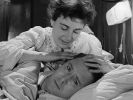Eye For Film >> Movies >> Woman In A Dressing Gown (1957) Film Review
I confess that I had never heard of J Lee Thompson's Woman in a Dressing Gown prior to reading Melanie Williams' piece on it in the August edition of Sight & Sound. As someone with both a personal and professional interest in British cinema this is either an unforgivable oversight on my part or symptomatic of the film's current status as something of a forgotten gem. I'd like to think it's the latter, mainly to spare my own blushes, and thankfully we all now have the opportunity to either be introduced to or re-acquainted with this groundbreaking slice of social realist drama.
Now remastered and back in cinemas, and with its debut release on DVD coming on August 13th, Woman in a Dressing Gown both predates the birth of the kitchen sink dramas and those revolving around the figures of the Angry Young Men that would appear at the end of the decade and the beginning of the sixties, thus revolutionizing British cinema and its representations of working class lives. Its pioneering gender politics, placing a middle aged housewife at the centre of its narrative, is another cause for celebration coupled with consternation as to why this, then radical and now still relevant, movie isn't more prominently recognised as a landmark of British cinema.

Written by Ted Willis, who provided the original treatment for the similarly groundbreaking police drama The Blue Lamp (Basil Dearden, 1950), before creating the subsequent TV series Dixon of Dock Green, Woman in a Dressing Gown is a tragi-comic portrayal of ordinary lives and the devastating impact on them of infidelity, the daily grind and the strains that the passage of time puts onto a marriage.
Starring Yvonne Mitchell as the titular woman, Amy Preston, the clumsy, untidy and frazzled wife of Anthony Quayle's Jim, a perpetually harangued, over-worked middle management employee, this peek behind the curtain at the supposedly blissful domesticity of marriage in 50s Britain shatters that particular illusion. A young Sylvia Sims features as Jim's secretary and 'other woman', Georgie Harlow, younger, prettier, more organised and aspirational than his, now dowdy, wife of twenty years. With their fresh faced son, Brian (Andrew Ray), starting to make his own way in life, the Preston's marriage, and their emotional states, are put under immense strain by Jim's extra-marital affair.
Thompson, better known for directing more testosterone fueled movies such as Ice Cold in Alex (1958), The Guns of Navarone (1961) and Cape Fear (1962), directs with flair, a restless camera often prowling around the Preston's claustrophobically cluttered apartment, with swirling, out of focus POV shots introduced to visualize Amy's fraught emotions at times of duress. Willis' prescient, balanced and non-judgmental screenplay offers ample opportunity for the cast to deliver heartfelt, attention grabbing performances, none more so than Mitchell, who excels as the loving but emotionally frustrated wife at the centre of a movie that is in essence a bridging link between Brief Encounter (David Lean, 1945) and the later, dialogue driven domestic dramas as evinced by Mike Leigh.
Feminist politics, masculine crisis, youthful idealism, the institution of marriage and contemporary social mores criss-cross a narrative that thankfully eschews the traditionally condescending portrayal of working class lives that had featured in British cinema to that point. Bold in origin, captivating in delivery and resonant across the eras, Woman in a Dressing Gown may now rightfully assume its position as a watershed entry into the canon of British cinema. Recommended for anyone with a genuine interest in the evolution of not just our national cinema, but also the representation of women in a medium to this day dominated, onscreen and off, by men.
Reviewed on: 31 Jul 2012

















